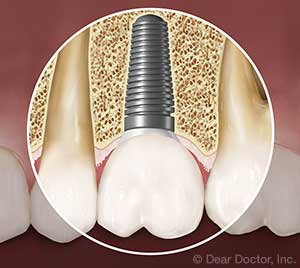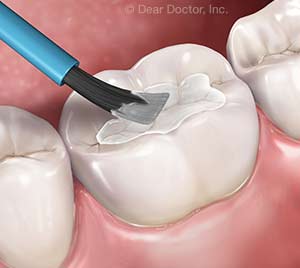Search Results
161 content pages
Smile Makeover
Smiling with confidence makes you feel great. A beautiful smile is also an important social and professional asset. Yet there are many people who avoid showing their teeth in public or in photographs because they don't like what they see. If that describes you, then why not start the process of getting the smile you've always wanted with a smile makeover?
A smile makeover goes beyond simply responding to dental problems as they arise. It's a comprehensive smile-rejuvenation plan that's uniquely suited to your own facial features and aesthetic preferences. The results can be quite dramatic — both in terms...

Aging and Dental Health
Today, Americans are not only living longer — we're also retaining our natural teeth longer than ever before. But this rosy picture isn't free of thorns: Older adults tend to require increasingly complex dental treatments; are often more prone to contracting certain diseases; and sometimes find it challenging to keep up with daily oral health practices.
Yet maintaining good oral hygiene is critically important as we age. When problems occur in the mouth, they can cause difficulty chewing, swallowing, speaking and smiling — basic functions which can affect both physical and social well-being. It's possible that medications prescribed for other...

Cosmetic Dentistry
It's impossible to overstate the emotional, social and professional benefits that smiling with confidence can give you. If you find you cover your mouth when you smile, or even hold back your smile because you don't want to show your teeth, you should consider what cosmetic dentistry — the art of smile enhancement — can do for you.
The first step in any smile makeover is a thorough dental examination, to make sure that your cosmetic problems really are just that, and not a sign of underlying dental disease. Once your health has been established, your smile can be cosmetically...

Cosmetic Gum Surgery
There are many elements that make up an ideal smile; bright, healthy-looking teeth immediately come to mind. But the gum tissue that surrounds and supports those teeth also plays a big role in how appealing your smile will look.
There are various cosmetic issues involving gum (gingival) tissue. For example, your smile may look “gummy” — meaning you seem to display too much gum tissue when you smile, or your teeth appear too short. Sometimes it's the opposite problem — your teeth appear too long because your gum tissue has receded (pulled back), exposing tooth-root surfaces that were covered at...

Same-Day Crowns (CAD/CAM)
A tooth that has been structurally damaged by decay or trauma sometimes needs to be crowned or “capped” so that it can look good and function properly again. A crown is a durable covering that is custom-made to fit over the entire tooth from the gum line up. Crown fabrication traditionally takes place in a dental laboratory. But these days, there's a much more convenient alternative: same-day crowns made in the dental office.
Advanced dental technology known as Computer-Aided Design/Computer-Aided Manufacturing, or CAD/CAM, makes it possible to fabricate laboratory-grade crowns and other dental restorations in minutes. It's an amazing innovation...

Facial Trauma and Reconstructive Surgery
When you were a youngster, did you ever get a black eye, chip a tooth or bruise your cheek? If so, you may have experienced a case (let's hope, a mild one!) of facial trauma. In many situations, however, facial trauma can be severe. Among its major causes are auto accidents, sports injuries, work-related mishaps, falls, and acts of violence. When serious facial injury occurs, it's important that you receive immediate and comprehensive care. That's why oral and maxillofacial surgeons are on call at most emergency and trauma centers.
Facial trauma in general involves injuries to the soft- or hard-tissue...

Fixed Dentures
If you have lost an entire arch of teeth (top and/or bottom), or are soon to have your remaining teeth removed because they are too unhealthy to save, you may be able to replace them with fixed dentures supported by dental implants. Doctors and patients alike prefer fixed over removable dentures because they:
Look, feel and function just like natural teeth
Don't slip when you eat or talk
Help prevent bone loss in the jaw
Can last a lifetime
How It Works
Dental implants serve the same purpose as the roots of natural teeth: anchoring the replacement teeth to your...

Tips to Prevent Cavities
Cavities are little holes in teeth that can eventually cause big problems. They form when tooth-eroding acid attacks a tooth's protective outer covering (enamel). This acid mainly comes from two sources: your diet, and certain oral bacteria that thrive in the absence of effective oral hygiene. If cavities are not treated promptly, decay-causing bacteria can get further into the tooth, leading eventually to root-canal problems and even tooth loss. The good news is that cavities are preventable — meaning it is truly possible to keep all of your natural teeth for life! Here are our top three tips to keep...

Orthodontics and Surgery
Most of the time, individuals with misaligned teeth or other bite problems can be successfully treated with the many types of orthodontic appliances now available. Jaw development in a growing child can even be guided to improve tooth alignment when appropriate treatment is received before puberty. But sometimes, orthodontics alone isn't enough to correct problems with the teeth or jaws. That's when a surgical approach may be needed.
Corrective jaw surgery (also called orthognathic surgery) may be recommended for orthodontic problems that are skeletal in nature — meaning the misalignment of the bite is caused not by the position of...

Dental Implants
Of all the ways modern dentistry has to replace missing teeth, dental implants are by far the best. There is no tooth-replacement option that will give you a longer-lasting result. Implants also help preserve tooth-supporting bone that naturally deteriorates when a tooth is lost. Loss of bone is one of the major hidden consequences of losing teeth.
A dental implant most often takes the form of a small, screw-shaped titanium post that replaces the root-part of a missing tooth. The surgical procedure used to place an implant is actually quite minor and routine, requiring only local anesthesia in most cases....

Dental Sealants
The most likely location for a cavity to develop in your child's mouth is on the chewing surfaces of the back teeth. Run your tongue over this area in your mouth, and you will feel the reason why: These surfaces are not smooth, as other areas of your teeth are. Instead, they are filled with tiny grooves referred to as “pits and fissures,” which trap bacteria and food particles. The bristles on a toothbrush can't always reach all the way into these dark, moist little crevices. This creates the perfect conditions for tooth decay.
What's more, a child's newly erupted...

Dental X-Rays
X-rays are such a routine part of regular dental care today that it’s hard to imagine what a truly revolutionary impact they have made in dentistry. Discovered by German scientist Wilhelm Röntgen in 1895, x-rays were first utilized by doctors for viewing internal bodily structures in the early 20th Century. By mid-century, dentists were routinely using the technology to diagnose tooth decay and periodontal (gum) disease, as well as other diseases that are not visible through a clinical examination. The ability to see what’s inside the tooth and catch decay or gum disease at early stages has vastly improved the...

Laser Dentistry
They are inside your laptop computer and your DVD player, present on the factory floor and the supermarket checkout line. And now, lasers are finding increasing use in dentistry. Someday soon, you may have a routine dental procedure performed with the aid of a powerful, yet highly controllable beam of laser light, instead of a drill or a probe.
What are dentists currently using lasers for? These devices have been proven to help in the detection and treatment of oral diseases. They can be used for treating gum disease, detecting cancer, and pinpointing tooth decay in its early stages. They...

Whitening Traumatized Teeth
Teeth whitening is one of the most popular cosmetic dental treatments — and it's easy to see why. Having whiter teeth can make you look years younger, and the procedure itself is among the most conservative (and cost-effective) cosmetic treatments dentistry offers. Sometimes, however, achieving a pleasing, even shade of lightness can be challenging; this is particularly true when a tooth that needs to be lightened has been subjected to an injury (dental trauma) in the past.
Dental trauma encompasses any damage to the tooth that's caused by an external agent, whether accidental or intended. It may be due to...

Foods to Avoid With Braces
With braces, you're on your way to a beautiful smile. While you are on this exciting journey, please be aware that eating certain types of food can damage the wires or brackets — and make your daily oral hygiene routine more challenging. Not to worry, your orthodontic treatment will all be worth it in the end! But in the meantime you'll want to pay special attention to what you eat. Let's start with the foods you should avoid.
What You Should NOT Eat With Braces:
Popcorn
Popcorn hulls can get stuck under braces, where they are very difficult to remove....